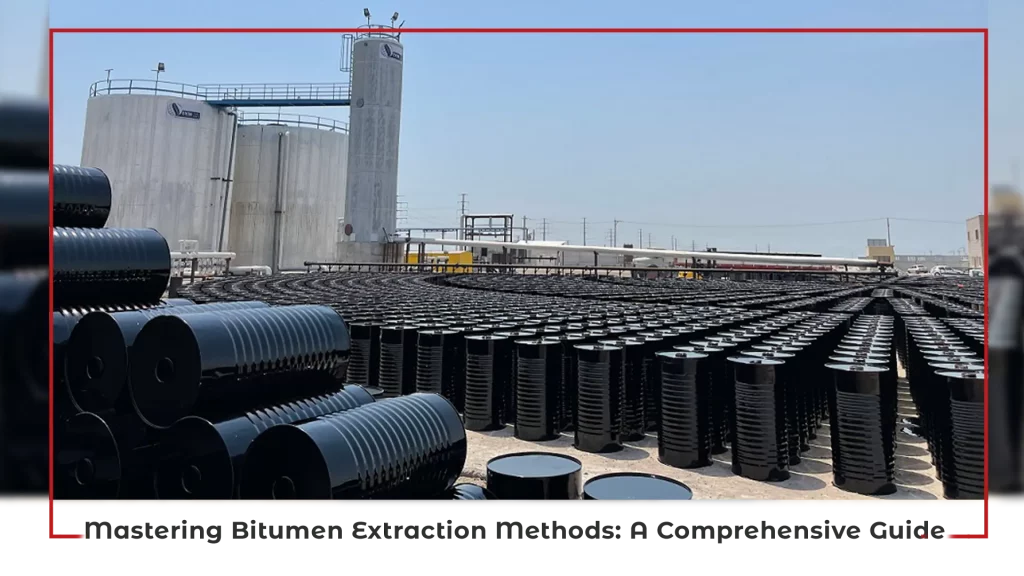Bitumen, a vital component in the construction and road-building industries, is extracted from natural deposits and oil sands through a range of sophisticated methods. In this official text, we will delve into the world of bitumen extraction methods, uncovering the processes, technologies, and innovations that drive this essential industry forward. From open-pit mining to in-situ recovery, each technique plays a pivotal role in the extraction of bitumen, meeting global infrastructure demands.
Introduction to Bitumen Extraction Methods
Bitumen, often referred to as asphalt or tar, is a viscous, black, and sticky substance that serves as the binding agent in various construction applications. It’s extracted from naturally occurring deposits or found within oil sands, requiring specific methods for efficient recovery. This comprehensive guide explores the various extraction techniques employed in the bitumen industry.
Open-Pit Mining
One of the most traditional methods for bitumen extraction is open-pit mining. This method is typically used when the bitumen deposit is close to the surface. It involves excavating the earth, removing overburden, and exposing the bitumen-rich layers. The exposed bitumen is then scooped up and transported to processing facilities.
Open-pit mining offers advantages in terms of extraction rate and is suitable for large-scale operations. However, it can have significant environmental impacts due to the removal of large quantities of soil and rock. Proper reclamation and environmental management are crucial in mitigating these effects.
In-Situ Recovery
In-situ recovery methods are employed when the bitumen deposit lies too deep to be economically excavated through open-pit mining. These techniques extract bitumen directly from the underground reservoirs, reducing the environmental footprint associated with surface mining.
One popular in-situ recovery method is Steam-Assisted Gravity Drainage (SAGD), which involves injecting steam into the reservoir to heat the bitumen, making it flow to a collection well. Another method is Cold Heavy Oil Production with Sand (CHOPS), which relies on the natural pressure of the reservoir to bring bitumen to the surface.
Solvent Extraction
Solvent extraction is a chemical-based method used to separate bitumen from the oil sands. In this process, solvents are mixed with the oil sands, dissolving the bitumen and leaving the sand behind. The solvent-bitumen mixture is then separated, and the solvent is recovered for reuse.
Solvent extraction is known for its high bitumen recovery rate and is often used for oil sands that are too deep for open-pit mining but not suitable for in-situ methods. However, it requires careful management of solvents to minimize environmental impacts.
Froth Treatment
Froth treatment is a crucial step in processing bitumen extracted from oil sands using methods like mining or solvent extraction. It involves creating a frothy mixture of bitumen, water, and fine solids. Air is introduced, causing bitumen to float to the top, where it can be skimmed off and further processed.
This method helps separate bitumen from impurities and water, making it suitable for transportation and refining. Froth treatment is an essential component of oil sands processing facilities and ensures the production of high-quality bitumen products.
Electromagnetic Heating
Electromagnetic heating is an emerging technology used in in-situ recovery methods. It involves the use of electromagnetic waves to heat the bitumen reservoir, reducing its viscosity and allowing it to flow more easily. This innovative approach can be more energy-efficient and environmentally friendly compared to traditional steam injection methods.
One advantage of electromagnetic heating is its precision in targeting specific areas of the reservoir, which can optimize bitumen recovery. It also minimizes water usage and greenhouse gas emissions, making it a sustainable option for bitumen extraction.
Tailings Management
Bitumen extraction processes generate a byproduct known as tailings, which consist of water, fine clay particles, and residual bitumen. Managing these tailings is a critical aspect of responsible bitumen extraction. Various methods, including centrifugation, settling ponds, and chemical treatments, are employed to separate and process tailings, allowing for safe disposal or reuse. Tailings management is subject to strict environmental regulations, as improperly handled tailings can have detrimental effects on local ecosystems and water sources. Companies in the bitumen industry are continually researching and implementing more sustainable tailings management practices.
Environmental Considerations
The extraction of bitumen, like any resource-intensive industry, has environmental implications. It’s essential to strike a balance between meeting the world’s infrastructure needs and minimizing ecological impacts. This includes land reclamation, water management, and reducing greenhouse gas emissions associated with extraction processes.
Recent advancements in technologies and practices are addressing these concerns, making bitumen extraction more environmentally responsible. Investments in research and development continue to drive innovation in sustainable extraction methods.
Conclusion and Future Outlook
In conclusion, bitumen extraction methods play a pivotal role in meeting the demands of the construction and infrastructure industries. From open-pit mining to in-situ recovery, each method has its advantages and challenges. With a growing emphasis on sustainability and environmental responsibility, the industry is evolving to adopt more efficient and eco-friendly practices.
As we move forward, expect to see further innovations in bitumen extraction, with an increased focus on reducing environmental impacts and improving resource efficiency. The future of bitumen extraction is not only about meeting our construction needs but also ensuring a sustainable and greener tomorrow.

